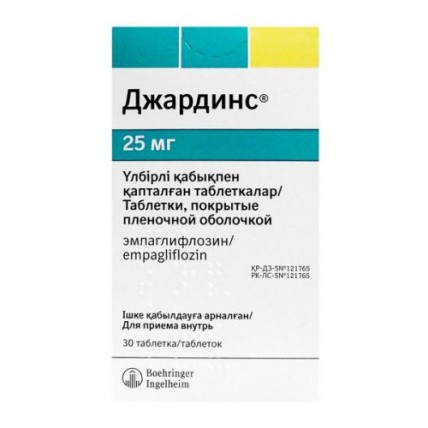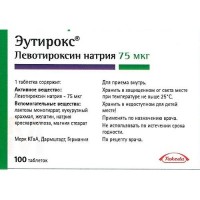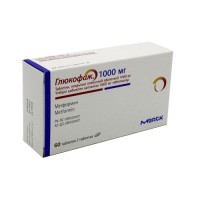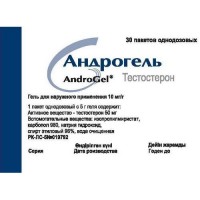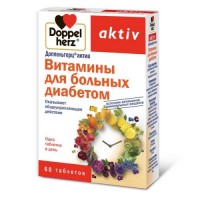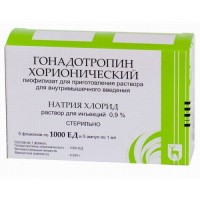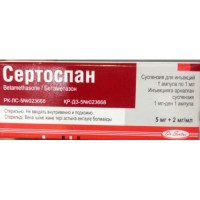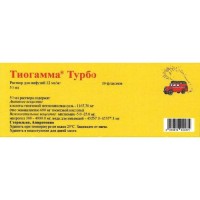Jardiance 30s 25 mg film-coated tablets
- $152.90
The instruction for medical use of DZhARDINS medicine the Trade name of DZhARDINS the International unlicensed name Empagliflozin Lekarstvennaya the Tablet form, film coated 10 mg, 25 mg Structure One tablet contains active agent - empagliflozin 10 mg or 25 mg, excipients: lactoses monohydrate, cellulose microcrystalline, hydroxypropyl cellulose, sodium of a kroskarmelloz, silicon dioxide colloidal anhydrous, magnesium stearate, structure of a cover of Opadray® yellow 02B38190: gipromelloza 2910, titan dioxide (E171), talc, macrogoal 400, ferrous oxide yellow (E172). The description Round biconvex tablets with slanted edges, film coated, pale yellow color with a print of S10 on one party of a tablet and a logo of the company on other party (for a dosage of 10 mg). Oval biconvex tablets, film coated, pale yellow color, with a print of S25 on one party of a tablet and a logo of the company on other party (for a dosage of 25 mg). Pharmacotherapeutic group Drugs, for treatment of diabetes. Glucose-lowering drugs for oral administration. Other glucose-lowering drugs. Empagliflozin. ATX A10BX12 code Pharmacological Pharmacokinetics Absorption properties: after intake empagliflozin it is quickly soaked up, the maximum concentration in blood plasma (Cmax) is reached in 1.5 hours. Decrease in concentration of drug in plasma has two-phase character with a fast phase of distribution and rather slow terminal phase. The area under a curve concentration time of AUC and Cmax of average concentration in plasma in a stage of dynamic equilibrium is made by 1870 nmol/h and the 259th nmol/l at reception of an empagliflozin in a dose of 10 mg and the 4740th nmol/h and the 687th nmol/l at reception of an empagliflozin in a dose of 25 mg once a day. Increase in system influence of an empagliflozin happens in proportion to increase in a dose. Pharmacokinetic parameters of single dose of an empagliflozin and in a stage of dynamic equilibrium are similar that testifies to linear pharmacokinetics concerning time. The pharmacokinetics of an empagliflozin at healthy volunteers and at patients with diabetes 2 types (SD 2) is well studied and is similar. Use of an empagliflozin in a dosage of 25 mg after intake of greasy and high-calorific food causes insignificant decrease in influence of drug, the AUC value decreases approximately by 16%, Cmax approximately for 37% in comparison with administration of drug on an empty stomach. Meal has no clinically significant impact on pharmacokinetics of an empagliflozin. Distribution: distribution volume in an equilibrium state in blood plasma is 73.8 l. Linking of a marked empagliflozin
with erythrocytes at healthy volunteers approximately - 37%, and with proteins of plasma – 86.2%. Metabolism: the main way of metabolism empagliflozina-a glyukuronization with participation uridine-5 '-diphospho-glyukuronoziltransferaz UGT2B7, UGT1A3, UGT1A8 and UGT1A9. The main metabolites of an empagliflozin in plasma of the person are not revealed, the most widespread metabolites of an empagliflozin are three glucuronic conjugates (2-O, 3-O and 6-O glucuronide). System influence of each metabolite less than 10% of the general influence of an empagliflozin of the general influence of the substances connected with drug. Removal: elimination half-life about 12.4 hours, clearance - 10.6 l/hour. The variability between patients and residual variability of clearance at oral administration of an empagliflozin is made by 39.1% and 35.8% respectively. At reception of an empagliflozin once a day steady concentration in blood plasma is reached after reception of the fifth dose. In a stage of dynamic equilibrium, according to elimination half-life, cumulation is up to 22% (on AUC in plasma). Removal of an empagliflozin makes about 96%: with a stake - 41% and with urine - 54%. In not changed view with a stake the most part of marked drug is removed. Kidneys in not changed look remove about a half of marked drug. Pharmacokinetics at special groups of patients of the Renal failure. At patients with a renal failure of light, average and heavy severity (SKF & lt, 30-<, 90 ml/min. / 1.73 sq.m) and at patients with an end-stage of the chronic disease of kidneys (CDK) of AUC value of an empagliflozin increase respectively by 18%, 20%, 66% and 48%, in comparison with patients with normal function of kidneys. At patients to a renal failure of moderate severity and at patients with HBP end-stage the maximum concentration of an empagliflozin in plasma was similar to the corresponding values at patients with normal function of kidneys. At patients with light and moderate severity of a renal failure the maximum concentration of an empagliflozin in plasma makes about 20% above, than at patients with normal function of kidneys. Data of the pharmacokinetic analysis show that the clearance of an empagliflozin decreases in process of reduction in the rate of glomerular filtration (SKF) that leads to drug influence strengthening. Abnormal liver functions. At patients with slight, moderate and heavy abnormal liver functions (according to classification of Chayld-Pyyu) AUC values of an empagliflozin increase approximately by 23%, 47% and 75%, and Cmax values approximately for 4%, 23% and 48% in comparison with patients with normal function of a liver. Body Mass Index (BMI). According to the pharmacokinetic analysis the body mass index does not make clinically significant impact on pharmacokinetic properties of an empagliflozin. A floor, advanced age have no clinically significant impact on pharmacokinetics of an empagliflozin. Race. The AUC value was 13.5% higher at representatives of Asian race with the body mass index of 25 kg/sq.m in comparison with representatives of other races with the body mass index of 25 kg/sq.m. The pharmacodynamics Empagliflozin is a reversible, highly active, selection and competitive inhibitor sodium - the dependent carrier of glucose 2 types (SGLT2) (IC50 1,3 nmol). Empagliflozin does not inhibit other important carriers of glucose in peripheral fabrics, by 5000 times more selektiven in relation to SGLT2, than to SGLT1, the main conveyor which is responsible for absorption of glucose in intestines. The activity of SGLT2 high in kidneys whereas in other fabrics its activity is absent or is shown in small degree. SGLT2 – the main conveyor which is responsible for a glucose reabsorption from a glomerular filtrate back in a blood stream. Patients with SD have 2 types and the glycemia filters and reabsorbirutsya the increased amount of glucose. Empagliflozin improves glycemic control at patients with SD 2 types by decrease in a reabsorption of glucose in kidneys. The amount of the glucose emitted by kidneys by means of the glyukuretichesky mechanism depends on concentration of glucose in blood and SKF. SGLT2 inhibition at patients with SD and a hyperglycemia leads 2 types to the increased glucose removal by kidneys. Clinical trials established that at patients with SD 2 types glucose removal by kidneys increases at once after use of the first dose of an empagliflozin and more than 24 hours remain. Increase in removal of glucose kidneys was supported until the end of the 4-week period of treatment, averaging about 78 g/day. At patients with SD the increase in level of removal of glucose kidneys leads 2 types to immediate decrease in concentration of glucose in blood plasma. Empagliflozin reduces concentration of glucose in blood plasma as on an empty stomach, and postprandialny. The mechanism of action of an empagliflozin does not depend on a functional condition of beta cells of a pancreas and metabolism of insulin, and promotes low risk of development of a hypoglycemia. Positive influence of an empagliflozin on surrogate markers of function of beta cells, including the HOMA-β index (homeostasis-B assessment model) is noted. Besides, glucose removal by kidneys leads to loss of calories that is followed by reduction of volume of fatty tissue and decrease in body weight. The glucosuria observed during use of an empagliflozin is followed by small increase in a diuresis which can promote a long and moderate lowering of arterial pressure. Clinical efficiency and safety In numerous clinical trials in which empagliflozin it was applied in a look: monotherapies, with metformin, including in group of the patients who were not taking earlier given drugs, additions to combination therapy with metformin and derivatives of sulphonylurea, combination therapy with pioglitazony with / or without metformin, combination therapy with linagliptiny at the patients who were not taking earlier given drugs, combination therapy with linagliptiny and metformin, combination therapy with metformin in comparison with glimepiridy, combination therapy with inhibitor dipeptidilpeptidazy-4 (DPP-4), metformin and other hypoglycemic oral medicine or without it, combination therapy with repeated daily doses of insulin, addition to combination therapy with basal insulin with metformin and/or derivatives of sulphonylurea or without it, addition to anti-diabetic therapy in group of patients with a renal failure the significant decrease in glikozilirovanny HbA1c hemoglobin, reduction of concentration of glucose of plasma on an empty stomach, decrease in body weight, systolic and diastolic arterial blood pressure was proved to combination therapy. During the prospective metaanalysis on the basis of these clinical trials ІІ and ІІІ phases it is established what empagliflozin does not increase risk of negative impact on a cardiovascular system. Use of an empagliflozin in a dosage of 25 mg led to increase in number of the patients who reached the target HbA1c level in comparison with groups of patients who accepted empagliflozin in a dosage 10 mg and placebo. Treatment using an empagliflozin as addition to metformin or metformin in a combination with derivatives of sulphonylurea led to clinically significant improvement of level of glucose in 2 hours after meal. Patients with the high initial level of glikozilirovanny HbA1c & gt hemoglobin, 10% have an open treatment empaglifloziny in a dosage of 25 mg led to decrease in the HbA1c level substantially. Indications Diabetes 2 types for improvement of control of level of glucose in blood in quality: monotherapies at insufficient efficiency of a dietotherapy and physical exercises at patients with inadequate glycemic control and intolerance of metformin of combination therapy with other hypoglycemic means, including insulin when the performed therapy together with a diet and physical exercises does not provide necessary glycemic control the Route of administration and Monoterapiya's doses or combination therapy the Recommended initial dose are made by 10 mg of an empagliflozin (1 tablet a dosage of 10 mg) once a day at monotherapy or combination therapy in combination with other hypoglycemic medicines, including with insulin. For patients with good tolerance of an empagliflozin in a dosage of 10 mg and SKF & gt, 60 ml/min. / 1.73 in sq.m if more stringent glycemic control is necessary, the dose can be increased up to 25 mg (1 tablet by a dosage of 25 mg once a day). The maximum daily dose makes 25 mg. At use of an empagliflozin in a combination with derivatives of sulphonylurea or insulin for reduction of risk of a hypoglycemia the decrease in a dosage derivative sulphonylurea or insulin is possible. Special groups of patients Patients with renal failures. In a renal failure with SKF ≥ 60 ml/min. / 1.73 or at clearance of creatinine ≥ 60 ml/min. of dose adjustment are not required to sq.m. Patients who SKF have less than 60 ml/min. / 1.73 sq.m or clearance of creatinine lower than 60 ml/min. should not begin reception of an empagliflozin. For patients with good tolerance of an empagliflozin at whom SKF is stable lower than 60 ml/min. / 1.73 sq.m or clearance of creatinine 60 ml/min. are lower, the dose of an empagliflozin has to be corrected or be supported at the level of 10 mg once a day. It is necessary to stop administration of drug to patients with renal failures with the SKF steady value less than 45 ml/min. / 1.73 sq.m or if clearance of creatinine stable lower than 45 ml/min. Patients with an end-stage of HBP or to the patients who are on dialysis should not accept empagliflozin in connection with its inefficiency. Patients with abnormal liver functions. With abnormal liver functions of dose adjustment it is not required to patients. The effect of an empagliflozin amplifies in a heavy abnormal liver function. Experience of use of an empagliflozin for patients with heavy abnormal liver functions is limited and therefore it is not recommended at this group. Elderly patients. Dose adjustment is not required from this group of patients. At administration of drug by patients at the age of 75 years is also more senior it is necessary to consider the increased risk of dehydration. To patients at the age of 85 years is also more senior it is not recommended to begin treatment empaglifloziny because of limited experience of use. Route of administration. The pill should be taken once a day, washing down with water, irrespective of meal. At the admission of a dose the patient should take the drug as soon as he remembers it. Reception of a double dose of drug in one day is not allowed. Side effects This medicine is a subject of additional monitoring for detection of new information on safety of drug. We ask medical experts to report about any expected undesirable reactions. The patients receiving empagliflozin or placebo in clinical trials had a similar general frequency of the undesirable phenomena. The hypoglycemia noted at use of an empagliflozin in a combination with derivatives of sulphonylurea or insulin was the most frequent undesirable reaction. The undesirable phenomena observed at the patients receiving empagliflozin during clinical trials are given in the table below with use of the following classification: very often ≥ 1/10, it is frequent ≥1/100 to & lt, 1/10, infrequently ≥1/1000 to & lt, 1/100, is rare ≥1/10000 to & lt, 1/1000, also lt, 1/10000 is very rare, also undesirable reactions which frequency is unknown are allocated (it cannot be estimated on the basis of the available data). Infectious and parasitic diseases Often: vaginal candidiasis, a vulvovaginitis, a balanitis and other genital infections, infections of urinary tract of Disturbance from metabolism and food It is very frequent: a hypoglycemia (at combined use with derivatives of sulphonylurea or insulin) Disturbances from integuments Often: an itching (generalized) Disturbances from a cardiovascular system Infrequently: reduction of volume of the circulating Disturbance liquid from kidneys and urinary tract is frequent: the speeded-up urination Infrequently: dysuria Description of separate undesirable reactions. The hypoglycemia the Frequency of development of a hypoglycemia depends on the performed accompanying hypoglycemic therapy. Frequency of development of an easy hypoglycemia the patients accepting empagliflozin or placebo in the form of monotherapy had a similar easy degree of a hypoglycemia and also in case of a combination of an empagliflozin with metformin and also with pioglitazony (with metformin or without it). The increased frequency of cases was noted at a drug combination with metformin and to sulphonylurea derivatives and also at a drug combination with insulin (with metformin or without it and with derivatives of sulphonylurea or without them) within the first 18 weeks of treatment at impossibility of dose adjustment of insulin. Heavy degree of a hypoglycemia (hypoglycemia at which auxiliary therapy is required). Increase in frequency of cases of a hypoglycemia of heavy degree was not observed at reception of an empagliflozin as monotherapy in comparison with placebo, as addition to intake of metformin and derivatives of sulphonylurea and also as addition to reception of a pioglitazon with metformin or without it. The increased frequency of cases was noted at a drug combination with insulin (with metformin or without it and with derivatives of sulphonylurea or without them). Genital infections. Frequency of development of such undesirable phenomena as vaginal candidiasis, a vulvovaginitis, a balanitis and other genital infections was higher in case of use of an empagliflozin, than at placebo use. These infections were more often noted at the women receiving treatment empaglifloziny in compare
AI to placebo. The difference in the frequency of cases of infections among men was less expressed. The severity of genital infections was weak or moderate. The speeded-up urination. Frequency of the speeded-up urination (such symptoms as a pollakiuria, a polyuria, a nocturia were estimated) was higher in case of use of an empagliflozin, than in case of placebo use. Frequency of development of a nocturia was comparable in both groups of patients. The expressiveness of these side effects was weak or moderate. Infections of urinary tract. The general frequency of development of infections of urinary tract was similar in case of use of an empagliflozin of 25 mg and placebo above in case of use of an empagliflozin of 10 mg. Also as, and in case of use of placebo, infections of urinary tract against the background of reception of an empagliflozin were more often noted at patients with persistent and recurrent infections of urinary tract in the anamnesis. The intensity of infections of urinary tract (weak, moderate and heavy) was similar at the patients accepting empagliflozin and placebo. Infections of urinary tract were more often noted at women, at men of difference in the frequency of cases of infections are noted. Reduction of volume of the circulating liquid. The frequency of development of a hypovolemia which is expressed by decrease in systolic arterial blood pressure, dehydration, hypotension, a hypovolemia, orthostatic arterial hypotension and a faint) was similar in case of use of an empagliflozin and placebo. Frequency of cases of reduction of volume of the circulating liquid increased at patients at the age of 75 years and is more senior at treatment placebo, empaglifloziny in comparison with group. Contraindications hypersensitivity to active agent, to any of auxiliary components of drug diabetes of the I type diabetic ketoacidosis the glomerular filtration rate & lt, 45 ml/min. / 1.73 sq.m dialysis rare hereditary diseases (deficiency of lactose, a lactose intolerance, glyukozo-galaktozny malabsorption) pregnancy and the period of breastfeeding age are more senior than 85 years children's age up to 18 years Medicinal interactions Pharmakodinamichesky interactions Diuretics. Empagliflozin can enhance diuretic effect of thiazide and loopback diuretics and also can increase risk of dehydration and hypotension. Insulin and secretagogues of insulin. Insulin and secretagogues of insulin, such as sulphonylurea derivatives, can increase risk of a hypoglycemia. Therefore the dose decline of insulin or secretagogues of insulin at their use in combination with empaglifloziny can lead to reduction of risk of a hypoglycemia. Pharmacokinetic interactions Influence of other medicines on empagliflozin allow to conclude Data of researches in the conditions of in vitro that the main metabolic way of an empagliflozin represents a glyukuronirovaniye uridine-5-diphosphate UGT1A3, UGT1A8, UGT1A9 and UGT2B7 glucuronosyltransferase. Empagliflozin - substrate of human carriers of capture of OAT3, OATP1B1 and OATP1B3, but not OAT1 and OCT2. Empagliflozin - substrate of the R-glycoprotein (R-gp) and a squirrel of resistance of a breast cancer (BCRP). Joint reception of an empagliflozin with probenetsidy, inhibitor of UDF-enzymes and OAT3, leads to increase in Cmax by 26% and increase in AUC by 53%. These changes are not considered as clinically significant. Impact of induction of UDF on empagliflozin was not studied. It is necessary to avoid joint reception with the known inductors of UDF-enzymes in connection with potential risk of decrease in efficiency. The research of medicinal interaction with gemfibrozily, in vitro inhibitor of carriers of OAT3 and OATP1B1/1B3, showed that after joint reception of Cmax of an empagliflozin increased by 15%, and AUC increased by 59%. These changes are not considered as clinically significant. The inhibition of carriers of OATP1B1/1B3 the combined administration of drug with rifampicin caused increase by 75% of an indicator of Cmax and increase by 35% of an indicator of AUC of an empagliflozin. These changes are not considered as clinically significant. Identical influence of an empagliflozin with the combined intake of verapamil, R-gp inhibitor or without it was noted that demonstrates that inhibition R-gp has no clinically significant impact on empagliflozin. The researches of medicinal interaction conducted on healthy volunteers showed that the pharmacokinetics of an empagliflozin is not influenced by the combined administration of drug with metformin, glimepiridy, pioglitazony, sitagliptiny, linagliptiny, warfarin, verapamil, ramiprily, simvastatiny, torasemidy and a hydrochlorothiazide. Action of an empagliflozin on other medicines. On the basis of the researches in vitro the conclusion is made that empagliflozin does not inhibit, does not inactivate and does not induce CYP450 isoform. Empagliflozin does not inhibit UGT1A1. For this reason the medicinal interaction with participation of the main CYP450 or UGT1A1 isoforms between empaglifloziny and the substrates of these enzymes accepted together with it is considered improbable. The ability of an empagliflozin to inhibit UGT2B7 was not studied. Empagliflozin in therapeutic doses does not inhibit R-gp. Based on the researches in vitro, it is improbable that empagliflozin can interact with the drugs which are R-gp substrates. The combined intake of digoxin, R-gp substrate and an empagliflozin led to increase in AUC by 6% and Cmax by 14% of digoxin. These changes are not considered as clinically significant. Empagliflozin does not inhibit human carriers of capture, such as OAT3, OATP1B1 and OATP1B3 in vitro in clinically significant concentration in plasma. For this reason the medicinal interaction with substrates of such carriers of capture is considered improbable. Empagliflozin does not make clinically significant impact on pharmacokinetics of metformin, a glimepirid, a pioglitazon, a sitagliptin, a linagliptin, a simvastatin, warfarin, a ramipiril, digoxin, diuretics and oral contraceptives. Special instructions DZhARDINS should not be accepted to patients with diabetes І type and at treatment of diabetic ketoacidosis. Diabetic ketoacidosis development of diabetic ketoacidosis (DKA) in the patients accepting treatment by SGLT 2 inhibitors Is in rare instances possible including empagliflozin. In some cases manifestation of DKA was atypical, only with moderately increased values of glucose in blood, it is lower than 14 mmol/l (250 mg/dl). The risk of emergence of DKA is possible in case of development of not specific symptoms, such as nausea, vomiting, anorexia, abdominal pain, polydipsia, the complicated breath, confusion of consciousness, unusual fatigue or drowsiness. At emergence of these symptoms it is necessary to consider the complete or temporary cessation of the DZhARDINS drug treatment. Drug DZhARDINS should be used with care at the patients entering into group of the increased risk of emergence of DKA during intake of SGLT 2 inhibitors, including the patients who are on a diet with very low content of carbohydrates (increase in production of ketone bodies is possible), patients with the increased risk of dehydration and patients with ketoacidosis cases in the anamnesis which have a low stock of function of beta cells. It is necessary to be careful at an insulin dose decline at patients for whom insulin is necessary (cm. section Route of Administration and Doses). Drug use by patients with a renal failure (cm. section Route of Administration and Doses). Control of function of kidneys. Due to the mechanism of effect of drug the efficiency of an empagliflozin depends on function of kidneys. Therefore evaluating function of kidneys is recommended: - before an initiation of treatment empaglifloziny and periodically during treatment, at least once a year, - before an initiation of treatment any accompanying medicine which can negatively influence function of kidneys. Abnormal liver functions. During clinical trials of an empagliflozin, cases of an abnormal liver function were noted. Relationship of cause and effect between reception of an empagliflozin and abnormal liver functions was not established. Patients of advanced age. Impact of an empagliflozin on glucose discharge with urine is connected with an osmotic diuresis that can affect the level of saturation of an organism water (see the sections Route of Administration and Doses and Contraindications). Use of drug for patients with the increased risk of dehydration. On the basis of the mechanism of effect of SGLT 2 inhibitors the osmotic diuresis accompanying a therapeutic glucosuria can lead to a moderate lowering of arterial pressure. For this reason it is necessary to show extra care at treatment of patients with cardiovascular diseases, or patients at the age of 75 years and is more senior than the patients receiving hypotensive therapy with hypotension cases in the anamnesis. At emergence of conditions which can cause liquid loss by an organism (for example, digestive tract disorder) for the patients accepting empagliflozin the attentive observation of dehydration degree (i.e. data of physical inspection, measurement of arterial blood pressure, laboratory researches, including a hematocrit) and the level of electrolytes is recommended. It is necessary to consider the possibility of the temporary termination of treatment empaglifloziny until the water balance of an organism is not restored. Infections of urinary tract. It is necessary to consider the possibility of the temporary termination of treatment empaglifloziny for patients with the complicated infection of urinary tract (pyelonephritis or an urosepsis). Heart failure. Experience of use of drug for patients of class I-II on classification of the New York cardiological association (NYHA) is limited, data of clinical trials of an empagliflozin among patients of class III-IV on classification of NYHA are absent. Laboratory researches of urine. Due to the mechanism of effect of drug at the patients accepting DZhARDINS positive takes when determining glucose in urine will be noted. Lactose. Drug DZhARDINS contains lactose. Patients with the rare inherited disorders connected with intolerance of a galactose, a lactose intolerance or glyukozo-galaktozny malabsorption should not take this medicine. The fertility, pregnancy and the period of breastfeeding Researches of impact of drug DZhARDINS on reproductive function of the person were not conducted. Preclinical trials showed lack of direct or indirect harmful effects of drug on reproductive function. There are no data on use of an empagliflozin by pregnant women. Nevertheless, preclinical trials revealed the undesirable phenomena connected with post-natal development. As a precautionary measure the administration of drug of DZhARDINS is not recommended during pregnancy. There are no data on discharge of an empagliflozin in breast milk. However the available toxicological data of preclinical trials confirmed the fact of discharge of an empagliflozin in milk. Administration of drug of DZhARDINS is not recommended during feeding by a breast. Features of influence of medicine on ability to run the vehicle or potentially dangerous mechanisms Patients have to be prevented about need to be careful at control of vehicles and mechanisms as at drug DZhARDINS use (especially in combinations with derivatives of sulphonylurea and/or insulin) the hypoglycemia can develop. Overdose Symptoms: patients with SD have 2 types at reception of a single dose of an empagliflozin up to 800 mg (by 32 times the exceeding maximum daily dose) and repeated doses up to 100 mg (by 4 times exceeding the maximum daily dose) the toxicity is not revealed. Empagliflozin increases glucose discharge with urine that leads to increase in volume of urine. Observed increase in volume of urine does not depend on the size of a dose and has no clinical value. Experience of use of the dose exceeding 800 mg no. Treatment: in case of overdose the removal of not absorbed drug from digestive tract, clinical control and symptomatic treatment is recommended. Removal of an empagliflozin by means of a hemodialysis is not studied. A form of release and packing On 10 tablets in blister strip packagings from a film of polyvinylchloride and aluminum foil. On 3 planimetric packs together with the instruction for medical use in the state and Russian languages put in a pack cardboard. To Store storage conditions at a temperature not higher than 25 wasps. To store out of children's reach! 3 years not to use a period of storage after the expiry date specified on packing. Prescription status According to the prescription of the doctor of Proiswoditel Boehringer Ingelcheim Pharm GmbH and To. KG, Germany the Owner of the registration certificate of Boehringer Ingelcheim International GmbH, Germany the Address of the organization accepting in the territory of the Republic of Kazakhstan claims from consumers on quality of products (goods): Representation Boehringer Ingelcheim of Pharm Hess mbkh in RK of Almaty, 050008
to Develop the ave of Abay 52, Business center Innova Tower, the 7th floor
with erythrocytes at healthy volunteers approximately - 37%, and with proteins of plasma – 86.2%. Metabolism: the main way of metabolism empagliflozina-a glyukuronization with participation uridine-5 '-diphospho-glyukuronoziltransferaz UGT2B7, UGT1A3, UGT1A8 and UGT1A9. The main metabolites of an empagliflozin in plasma of the person are not revealed, the most widespread metabolites of an empagliflozin are three glucuronic conjugates (2-O, 3-O and 6-O glucuronide). System influence of each metabolite less than 10% of the general influence of an empagliflozin of the general influence of the substances connected with drug. Removal: elimination half-life about 12.4 hours, clearance - 10.6 l/hour. The variability between patients and residual variability of clearance at oral administration of an empagliflozin is made by 39.1% and 35.8% respectively. At reception of an empagliflozin once a day steady concentration in blood plasma is reached after reception of the fifth dose. In a stage of dynamic equilibrium, according to elimination half-life, cumulation is up to 22% (on AUC in plasma). Removal of an empagliflozin makes about 96%: with a stake - 41% and with urine - 54%. In not changed view with a stake the most part of marked drug is removed. Kidneys in not changed look remove about a half of marked drug. Pharmacokinetics at special groups of patients of the Renal failure. At patients with a renal failure of light, average and heavy severity (SKF & lt, 30-<, 90 ml/min. / 1.73 sq.m) and at patients with an end-stage of the chronic disease of kidneys (CDK) of AUC value of an empagliflozin increase respectively by 18%, 20%, 66% and 48%, in comparison with patients with normal function of kidneys. At patients to a renal failure of moderate severity and at patients with HBP end-stage the maximum concentration of an empagliflozin in plasma was similar to the corresponding values at patients with normal function of kidneys. At patients with light and moderate severity of a renal failure the maximum concentration of an empagliflozin in plasma makes about 20% above, than at patients with normal function of kidneys. Data of the pharmacokinetic analysis show that the clearance of an empagliflozin decreases in process of reduction in the rate of glomerular filtration (SKF) that leads to drug influence strengthening. Abnormal liver functions. At patients with slight, moderate and heavy abnormal liver functions (according to classification of Chayld-Pyyu) AUC values of an empagliflozin increase approximately by 23%, 47% and 75%, and Cmax values approximately for 4%, 23% and 48% in comparison with patients with normal function of a liver. Body Mass Index (BMI). According to the pharmacokinetic analysis the body mass index does not make clinically significant impact on pharmacokinetic properties of an empagliflozin. A floor, advanced age have no clinically significant impact on pharmacokinetics of an empagliflozin. Race. The AUC value was 13.5% higher at representatives of Asian race with the body mass index of 25 kg/sq.m in comparison with representatives of other races with the body mass index of 25 kg/sq.m. The pharmacodynamics Empagliflozin is a reversible, highly active, selection and competitive inhibitor sodium - the dependent carrier of glucose 2 types (SGLT2) (IC50 1,3 nmol). Empagliflozin does not inhibit other important carriers of glucose in peripheral fabrics, by 5000 times more selektiven in relation to SGLT2, than to SGLT1, the main conveyor which is responsible for absorption of glucose in intestines. The activity of SGLT2 high in kidneys whereas in other fabrics its activity is absent or is shown in small degree. SGLT2 – the main conveyor which is responsible for a glucose reabsorption from a glomerular filtrate back in a blood stream. Patients with SD have 2 types and the glycemia filters and reabsorbirutsya the increased amount of glucose. Empagliflozin improves glycemic control at patients with SD 2 types by decrease in a reabsorption of glucose in kidneys. The amount of the glucose emitted by kidneys by means of the glyukuretichesky mechanism depends on concentration of glucose in blood and SKF. SGLT2 inhibition at patients with SD and a hyperglycemia leads 2 types to the increased glucose removal by kidneys. Clinical trials established that at patients with SD 2 types glucose removal by kidneys increases at once after use of the first dose of an empagliflozin and more than 24 hours remain. Increase in removal of glucose kidneys was supported until the end of the 4-week period of treatment, averaging about 78 g/day. At patients with SD the increase in level of removal of glucose kidneys leads 2 types to immediate decrease in concentration of glucose in blood plasma. Empagliflozin reduces concentration of glucose in blood plasma as on an empty stomach, and postprandialny. The mechanism of action of an empagliflozin does not depend on a functional condition of beta cells of a pancreas and metabolism of insulin, and promotes low risk of development of a hypoglycemia. Positive influence of an empagliflozin on surrogate markers of function of beta cells, including the HOMA-β index (homeostasis-B assessment model) is noted. Besides, glucose removal by kidneys leads to loss of calories that is followed by reduction of volume of fatty tissue and decrease in body weight. The glucosuria observed during use of an empagliflozin is followed by small increase in a diuresis which can promote a long and moderate lowering of arterial pressure. Clinical efficiency and safety In numerous clinical trials in which empagliflozin it was applied in a look: monotherapies, with metformin, including in group of the patients who were not taking earlier given drugs, additions to combination therapy with metformin and derivatives of sulphonylurea, combination therapy with pioglitazony with / or without metformin, combination therapy with linagliptiny at the patients who were not taking earlier given drugs, combination therapy with linagliptiny and metformin, combination therapy with metformin in comparison with glimepiridy, combination therapy with inhibitor dipeptidilpeptidazy-4 (DPP-4), metformin and other hypoglycemic oral medicine or without it, combination therapy with repeated daily doses of insulin, addition to combination therapy with basal insulin with metformin and/or derivatives of sulphonylurea or without it, addition to anti-diabetic therapy in group of patients with a renal failure the significant decrease in glikozilirovanny HbA1c hemoglobin, reduction of concentration of glucose of plasma on an empty stomach, decrease in body weight, systolic and diastolic arterial blood pressure was proved to combination therapy. During the prospective metaanalysis on the basis of these clinical trials ІІ and ІІІ phases it is established what empagliflozin does not increase risk of negative impact on a cardiovascular system. Use of an empagliflozin in a dosage of 25 mg led to increase in number of the patients who reached the target HbA1c level in comparison with groups of patients who accepted empagliflozin in a dosage 10 mg and placebo. Treatment using an empagliflozin as addition to metformin or metformin in a combination with derivatives of sulphonylurea led to clinically significant improvement of level of glucose in 2 hours after meal. Patients with the high initial level of glikozilirovanny HbA1c & gt hemoglobin, 10% have an open treatment empaglifloziny in a dosage of 25 mg led to decrease in the HbA1c level substantially. Indications Diabetes 2 types for improvement of control of level of glucose in blood in quality: monotherapies at insufficient efficiency of a dietotherapy and physical exercises at patients with inadequate glycemic control and intolerance of metformin of combination therapy with other hypoglycemic means, including insulin when the performed therapy together with a diet and physical exercises does not provide necessary glycemic control the Route of administration and Monoterapiya's doses or combination therapy the Recommended initial dose are made by 10 mg of an empagliflozin (1 tablet a dosage of 10 mg) once a day at monotherapy or combination therapy in combination with other hypoglycemic medicines, including with insulin. For patients with good tolerance of an empagliflozin in a dosage of 10 mg and SKF & gt, 60 ml/min. / 1.73 in sq.m if more stringent glycemic control is necessary, the dose can be increased up to 25 mg (1 tablet by a dosage of 25 mg once a day). The maximum daily dose makes 25 mg. At use of an empagliflozin in a combination with derivatives of sulphonylurea or insulin for reduction of risk of a hypoglycemia the decrease in a dosage derivative sulphonylurea or insulin is possible. Special groups of patients Patients with renal failures. In a renal failure with SKF ≥ 60 ml/min. / 1.73 or at clearance of creatinine ≥ 60 ml/min. of dose adjustment are not required to sq.m. Patients who SKF have less than 60 ml/min. / 1.73 sq.m or clearance of creatinine lower than 60 ml/min. should not begin reception of an empagliflozin. For patients with good tolerance of an empagliflozin at whom SKF is stable lower than 60 ml/min. / 1.73 sq.m or clearance of creatinine 60 ml/min. are lower, the dose of an empagliflozin has to be corrected or be supported at the level of 10 mg once a day. It is necessary to stop administration of drug to patients with renal failures with the SKF steady value less than 45 ml/min. / 1.73 sq.m or if clearance of creatinine stable lower than 45 ml/min. Patients with an end-stage of HBP or to the patients who are on dialysis should not accept empagliflozin in connection with its inefficiency. Patients with abnormal liver functions. With abnormal liver functions of dose adjustment it is not required to patients. The effect of an empagliflozin amplifies in a heavy abnormal liver function. Experience of use of an empagliflozin for patients with heavy abnormal liver functions is limited and therefore it is not recommended at this group. Elderly patients. Dose adjustment is not required from this group of patients. At administration of drug by patients at the age of 75 years is also more senior it is necessary to consider the increased risk of dehydration. To patients at the age of 85 years is also more senior it is not recommended to begin treatment empaglifloziny because of limited experience of use. Route of administration. The pill should be taken once a day, washing down with water, irrespective of meal. At the admission of a dose the patient should take the drug as soon as he remembers it. Reception of a double dose of drug in one day is not allowed. Side effects This medicine is a subject of additional monitoring for detection of new information on safety of drug. We ask medical experts to report about any expected undesirable reactions. The patients receiving empagliflozin or placebo in clinical trials had a similar general frequency of the undesirable phenomena. The hypoglycemia noted at use of an empagliflozin in a combination with derivatives of sulphonylurea or insulin was the most frequent undesirable reaction. The undesirable phenomena observed at the patients receiving empagliflozin during clinical trials are given in the table below with use of the following classification: very often ≥ 1/10, it is frequent ≥1/100 to & lt, 1/10, infrequently ≥1/1000 to & lt, 1/100, is rare ≥1/10000 to & lt, 1/1000, also lt, 1/10000 is very rare, also undesirable reactions which frequency is unknown are allocated (it cannot be estimated on the basis of the available data). Infectious and parasitic diseases Often: vaginal candidiasis, a vulvovaginitis, a balanitis and other genital infections, infections of urinary tract of Disturbance from metabolism and food It is very frequent: a hypoglycemia (at combined use with derivatives of sulphonylurea or insulin) Disturbances from integuments Often: an itching (generalized) Disturbances from a cardiovascular system Infrequently: reduction of volume of the circulating Disturbance liquid from kidneys and urinary tract is frequent: the speeded-up urination Infrequently: dysuria Description of separate undesirable reactions. The hypoglycemia the Frequency of development of a hypoglycemia depends on the performed accompanying hypoglycemic therapy. Frequency of development of an easy hypoglycemia the patients accepting empagliflozin or placebo in the form of monotherapy had a similar easy degree of a hypoglycemia and also in case of a combination of an empagliflozin with metformin and also with pioglitazony (with metformin or without it). The increased frequency of cases was noted at a drug combination with metformin and to sulphonylurea derivatives and also at a drug combination with insulin (with metformin or without it and with derivatives of sulphonylurea or without them) within the first 18 weeks of treatment at impossibility of dose adjustment of insulin. Heavy degree of a hypoglycemia (hypoglycemia at which auxiliary therapy is required). Increase in frequency of cases of a hypoglycemia of heavy degree was not observed at reception of an empagliflozin as monotherapy in comparison with placebo, as addition to intake of metformin and derivatives of sulphonylurea and also as addition to reception of a pioglitazon with metformin or without it. The increased frequency of cases was noted at a drug combination with insulin (with metformin or without it and with derivatives of sulphonylurea or without them). Genital infections. Frequency of development of such undesirable phenomena as vaginal candidiasis, a vulvovaginitis, a balanitis and other genital infections was higher in case of use of an empagliflozin, than at placebo use. These infections were more often noted at the women receiving treatment empaglifloziny in compare
AI to placebo. The difference in the frequency of cases of infections among men was less expressed. The severity of genital infections was weak or moderate. The speeded-up urination. Frequency of the speeded-up urination (such symptoms as a pollakiuria, a polyuria, a nocturia were estimated) was higher in case of use of an empagliflozin, than in case of placebo use. Frequency of development of a nocturia was comparable in both groups of patients. The expressiveness of these side effects was weak or moderate. Infections of urinary tract. The general frequency of development of infections of urinary tract was similar in case of use of an empagliflozin of 25 mg and placebo above in case of use of an empagliflozin of 10 mg. Also as, and in case of use of placebo, infections of urinary tract against the background of reception of an empagliflozin were more often noted at patients with persistent and recurrent infections of urinary tract in the anamnesis. The intensity of infections of urinary tract (weak, moderate and heavy) was similar at the patients accepting empagliflozin and placebo. Infections of urinary tract were more often noted at women, at men of difference in the frequency of cases of infections are noted. Reduction of volume of the circulating liquid. The frequency of development of a hypovolemia which is expressed by decrease in systolic arterial blood pressure, dehydration, hypotension, a hypovolemia, orthostatic arterial hypotension and a faint) was similar in case of use of an empagliflozin and placebo. Frequency of cases of reduction of volume of the circulating liquid increased at patients at the age of 75 years and is more senior at treatment placebo, empaglifloziny in comparison with group. Contraindications hypersensitivity to active agent, to any of auxiliary components of drug diabetes of the I type diabetic ketoacidosis the glomerular filtration rate & lt, 45 ml/min. / 1.73 sq.m dialysis rare hereditary diseases (deficiency of lactose, a lactose intolerance, glyukozo-galaktozny malabsorption) pregnancy and the period of breastfeeding age are more senior than 85 years children's age up to 18 years Medicinal interactions Pharmakodinamichesky interactions Diuretics. Empagliflozin can enhance diuretic effect of thiazide and loopback diuretics and also can increase risk of dehydration and hypotension. Insulin and secretagogues of insulin. Insulin and secretagogues of insulin, such as sulphonylurea derivatives, can increase risk of a hypoglycemia. Therefore the dose decline of insulin or secretagogues of insulin at their use in combination with empaglifloziny can lead to reduction of risk of a hypoglycemia. Pharmacokinetic interactions Influence of other medicines on empagliflozin allow to conclude Data of researches in the conditions of in vitro that the main metabolic way of an empagliflozin represents a glyukuronirovaniye uridine-5-diphosphate UGT1A3, UGT1A8, UGT1A9 and UGT2B7 glucuronosyltransferase. Empagliflozin - substrate of human carriers of capture of OAT3, OATP1B1 and OATP1B3, but not OAT1 and OCT2. Empagliflozin - substrate of the R-glycoprotein (R-gp) and a squirrel of resistance of a breast cancer (BCRP). Joint reception of an empagliflozin with probenetsidy, inhibitor of UDF-enzymes and OAT3, leads to increase in Cmax by 26% and increase in AUC by 53%. These changes are not considered as clinically significant. Impact of induction of UDF on empagliflozin was not studied. It is necessary to avoid joint reception with the known inductors of UDF-enzymes in connection with potential risk of decrease in efficiency. The research of medicinal interaction with gemfibrozily, in vitro inhibitor of carriers of OAT3 and OATP1B1/1B3, showed that after joint reception of Cmax of an empagliflozin increased by 15%, and AUC increased by 59%. These changes are not considered as clinically significant. The inhibition of carriers of OATP1B1/1B3 the combined administration of drug with rifampicin caused increase by 75% of an indicator of Cmax and increase by 35% of an indicator of AUC of an empagliflozin. These changes are not considered as clinically significant. Identical influence of an empagliflozin with the combined intake of verapamil, R-gp inhibitor or without it was noted that demonstrates that inhibition R-gp has no clinically significant impact on empagliflozin. The researches of medicinal interaction conducted on healthy volunteers showed that the pharmacokinetics of an empagliflozin is not influenced by the combined administration of drug with metformin, glimepiridy, pioglitazony, sitagliptiny, linagliptiny, warfarin, verapamil, ramiprily, simvastatiny, torasemidy and a hydrochlorothiazide. Action of an empagliflozin on other medicines. On the basis of the researches in vitro the conclusion is made that empagliflozin does not inhibit, does not inactivate and does not induce CYP450 isoform. Empagliflozin does not inhibit UGT1A1. For this reason the medicinal interaction with participation of the main CYP450 or UGT1A1 isoforms between empaglifloziny and the substrates of these enzymes accepted together with it is considered improbable. The ability of an empagliflozin to inhibit UGT2B7 was not studied. Empagliflozin in therapeutic doses does not inhibit R-gp. Based on the researches in vitro, it is improbable that empagliflozin can interact with the drugs which are R-gp substrates. The combined intake of digoxin, R-gp substrate and an empagliflozin led to increase in AUC by 6% and Cmax by 14% of digoxin. These changes are not considered as clinically significant. Empagliflozin does not inhibit human carriers of capture, such as OAT3, OATP1B1 and OATP1B3 in vitro in clinically significant concentration in plasma. For this reason the medicinal interaction with substrates of such carriers of capture is considered improbable. Empagliflozin does not make clinically significant impact on pharmacokinetics of metformin, a glimepirid, a pioglitazon, a sitagliptin, a linagliptin, a simvastatin, warfarin, a ramipiril, digoxin, diuretics and oral contraceptives. Special instructions DZhARDINS should not be accepted to patients with diabetes І type and at treatment of diabetic ketoacidosis. Diabetic ketoacidosis development of diabetic ketoacidosis (DKA) in the patients accepting treatment by SGLT 2 inhibitors Is in rare instances possible including empagliflozin. In some cases manifestation of DKA was atypical, only with moderately increased values of glucose in blood, it is lower than 14 mmol/l (250 mg/dl). The risk of emergence of DKA is possible in case of development of not specific symptoms, such as nausea, vomiting, anorexia, abdominal pain, polydipsia, the complicated breath, confusion of consciousness, unusual fatigue or drowsiness. At emergence of these symptoms it is necessary to consider the complete or temporary cessation of the DZhARDINS drug treatment. Drug DZhARDINS should be used with care at the patients entering into group of the increased risk of emergence of DKA during intake of SGLT 2 inhibitors, including the patients who are on a diet with very low content of carbohydrates (increase in production of ketone bodies is possible), patients with the increased risk of dehydration and patients with ketoacidosis cases in the anamnesis which have a low stock of function of beta cells. It is necessary to be careful at an insulin dose decline at patients for whom insulin is necessary (cm. section Route of Administration and Doses). Drug use by patients with a renal failure (cm. section Route of Administration and Doses). Control of function of kidneys. Due to the mechanism of effect of drug the efficiency of an empagliflozin depends on function of kidneys. Therefore evaluating function of kidneys is recommended: - before an initiation of treatment empaglifloziny and periodically during treatment, at least once a year, - before an initiation of treatment any accompanying medicine which can negatively influence function of kidneys. Abnormal liver functions. During clinical trials of an empagliflozin, cases of an abnormal liver function were noted. Relationship of cause and effect between reception of an empagliflozin and abnormal liver functions was not established. Patients of advanced age. Impact of an empagliflozin on glucose discharge with urine is connected with an osmotic diuresis that can affect the level of saturation of an organism water (see the sections Route of Administration and Doses and Contraindications). Use of drug for patients with the increased risk of dehydration. On the basis of the mechanism of effect of SGLT 2 inhibitors the osmotic diuresis accompanying a therapeutic glucosuria can lead to a moderate lowering of arterial pressure. For this reason it is necessary to show extra care at treatment of patients with cardiovascular diseases, or patients at the age of 75 years and is more senior than the patients receiving hypotensive therapy with hypotension cases in the anamnesis. At emergence of conditions which can cause liquid loss by an organism (for example, digestive tract disorder) for the patients accepting empagliflozin the attentive observation of dehydration degree (i.e. data of physical inspection, measurement of arterial blood pressure, laboratory researches, including a hematocrit) and the level of electrolytes is recommended. It is necessary to consider the possibility of the temporary termination of treatment empaglifloziny until the water balance of an organism is not restored. Infections of urinary tract. It is necessary to consider the possibility of the temporary termination of treatment empaglifloziny for patients with the complicated infection of urinary tract (pyelonephritis or an urosepsis). Heart failure. Experience of use of drug for patients of class I-II on classification of the New York cardiological association (NYHA) is limited, data of clinical trials of an empagliflozin among patients of class III-IV on classification of NYHA are absent. Laboratory researches of urine. Due to the mechanism of effect of drug at the patients accepting DZhARDINS positive takes when determining glucose in urine will be noted. Lactose. Drug DZhARDINS contains lactose. Patients with the rare inherited disorders connected with intolerance of a galactose, a lactose intolerance or glyukozo-galaktozny malabsorption should not take this medicine. The fertility, pregnancy and the period of breastfeeding Researches of impact of drug DZhARDINS on reproductive function of the person were not conducted. Preclinical trials showed lack of direct or indirect harmful effects of drug on reproductive function. There are no data on use of an empagliflozin by pregnant women. Nevertheless, preclinical trials revealed the undesirable phenomena connected with post-natal development. As a precautionary measure the administration of drug of DZhARDINS is not recommended during pregnancy. There are no data on discharge of an empagliflozin in breast milk. However the available toxicological data of preclinical trials confirmed the fact of discharge of an empagliflozin in milk. Administration of drug of DZhARDINS is not recommended during feeding by a breast. Features of influence of medicine on ability to run the vehicle or potentially dangerous mechanisms Patients have to be prevented about need to be careful at control of vehicles and mechanisms as at drug DZhARDINS use (especially in combinations with derivatives of sulphonylurea and/or insulin) the hypoglycemia can develop. Overdose Symptoms: patients with SD have 2 types at reception of a single dose of an empagliflozin up to 800 mg (by 32 times the exceeding maximum daily dose) and repeated doses up to 100 mg (by 4 times exceeding the maximum daily dose) the toxicity is not revealed. Empagliflozin increases glucose discharge with urine that leads to increase in volume of urine. Observed increase in volume of urine does not depend on the size of a dose and has no clinical value. Experience of use of the dose exceeding 800 mg no. Treatment: in case of overdose the removal of not absorbed drug from digestive tract, clinical control and symptomatic treatment is recommended. Removal of an empagliflozin by means of a hemodialysis is not studied. A form of release and packing On 10 tablets in blister strip packagings from a film of polyvinylchloride and aluminum foil. On 3 planimetric packs together with the instruction for medical use in the state and Russian languages put in a pack cardboard. To Store storage conditions at a temperature not higher than 25 wasps. To store out of children's reach! 3 years not to use a period of storage after the expiry date specified on packing. Prescription status According to the prescription of the doctor of Proiswoditel Boehringer Ingelcheim Pharm GmbH and To. KG, Germany the Owner of the registration certificate of Boehringer Ingelcheim International GmbH, Germany the Address of the organization accepting in the territory of the Republic of Kazakhstan claims from consumers on quality of products (goods): Representation Boehringer Ingelcheim of Pharm Hess mbkh in RK of Almaty, 050008
to Develop the ave of Abay 52, Business center Innova Tower, the 7th floor
